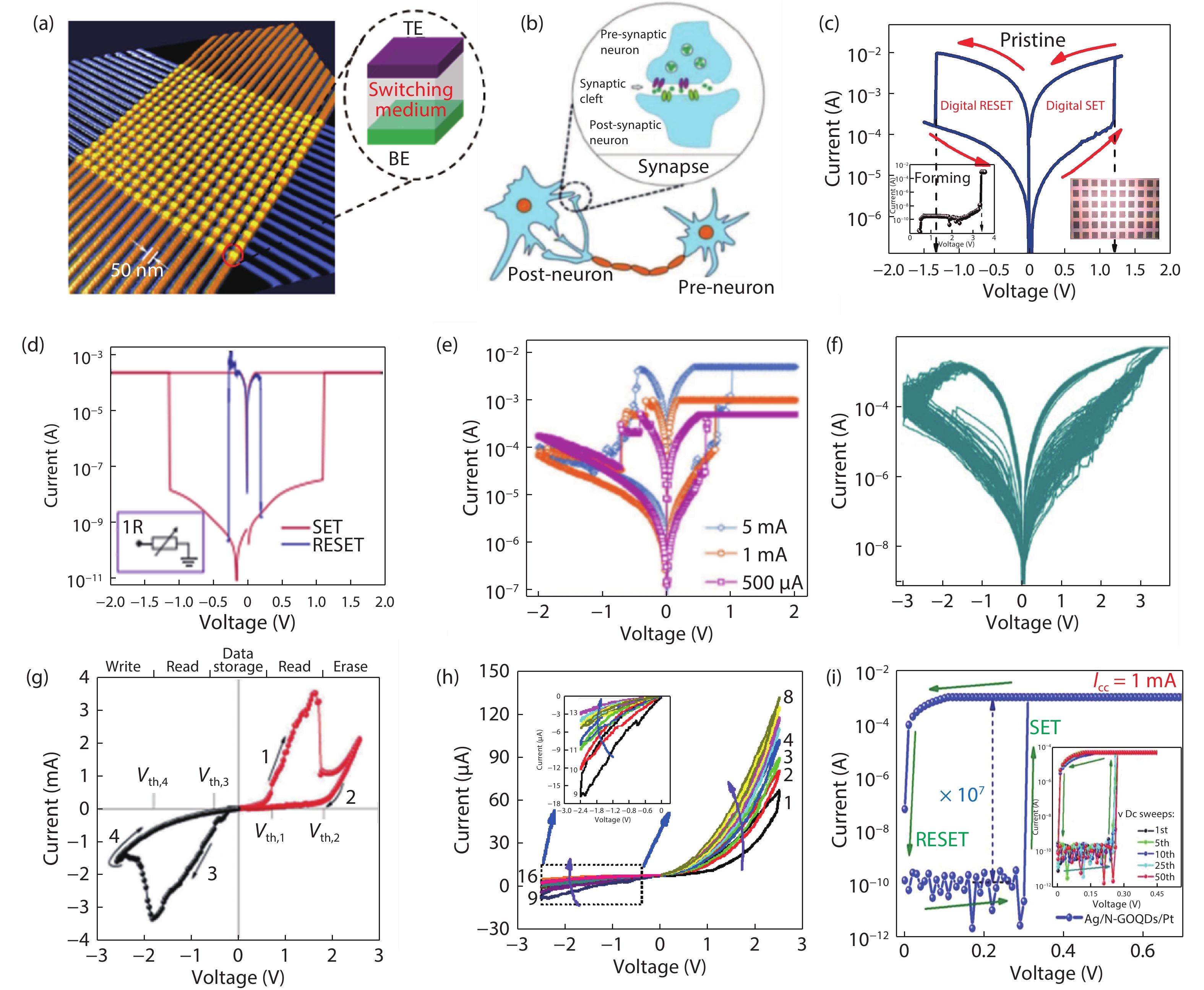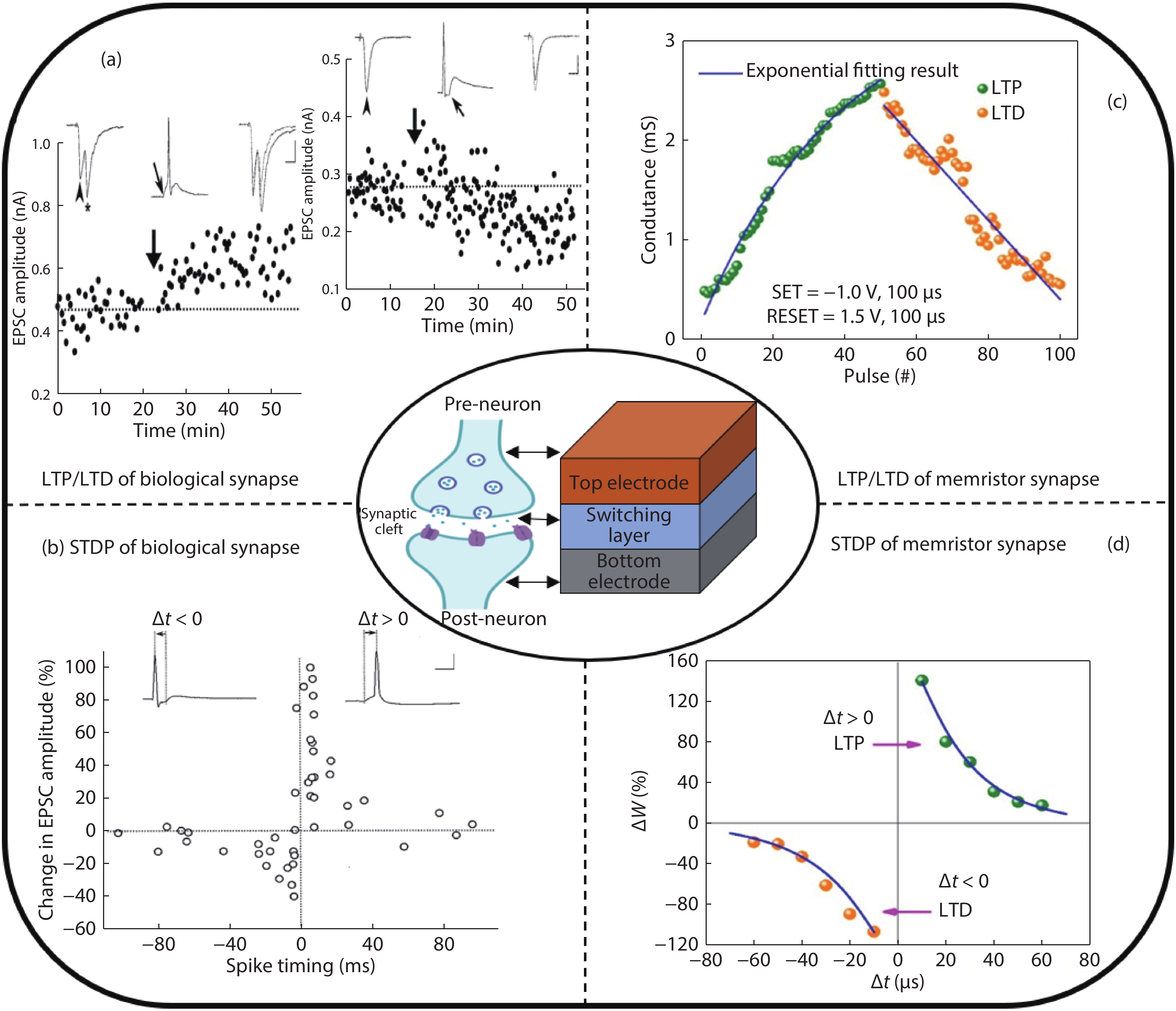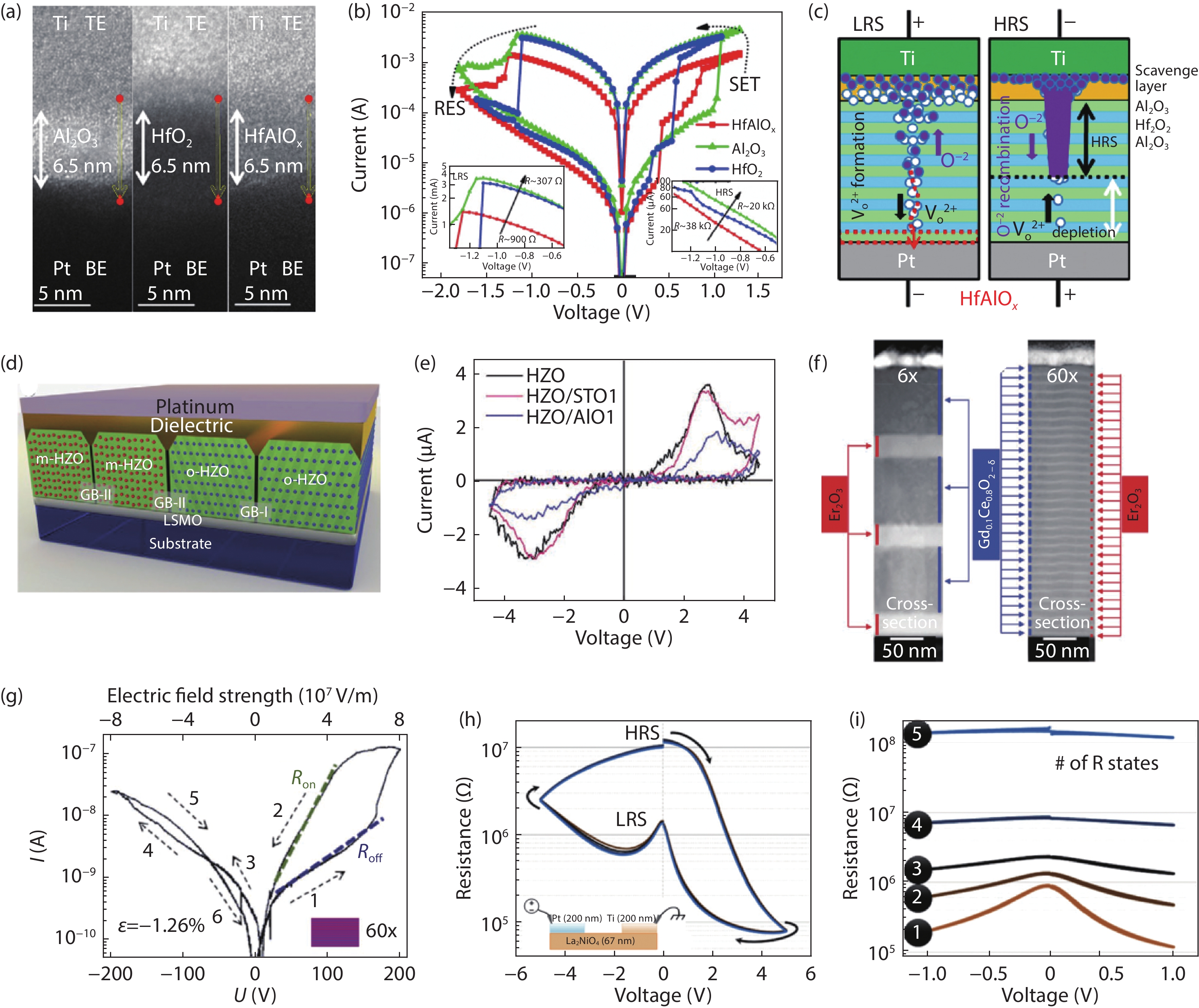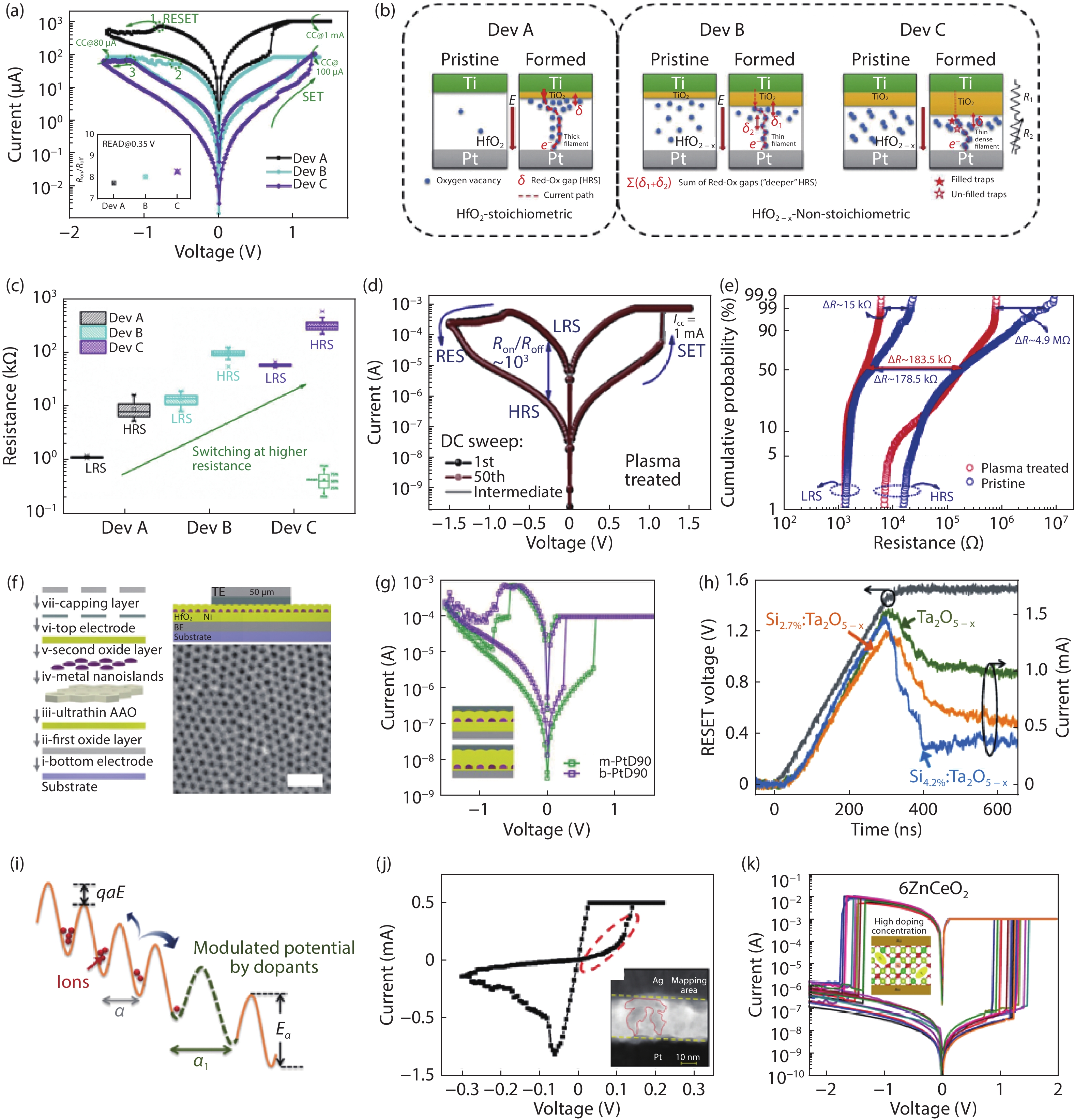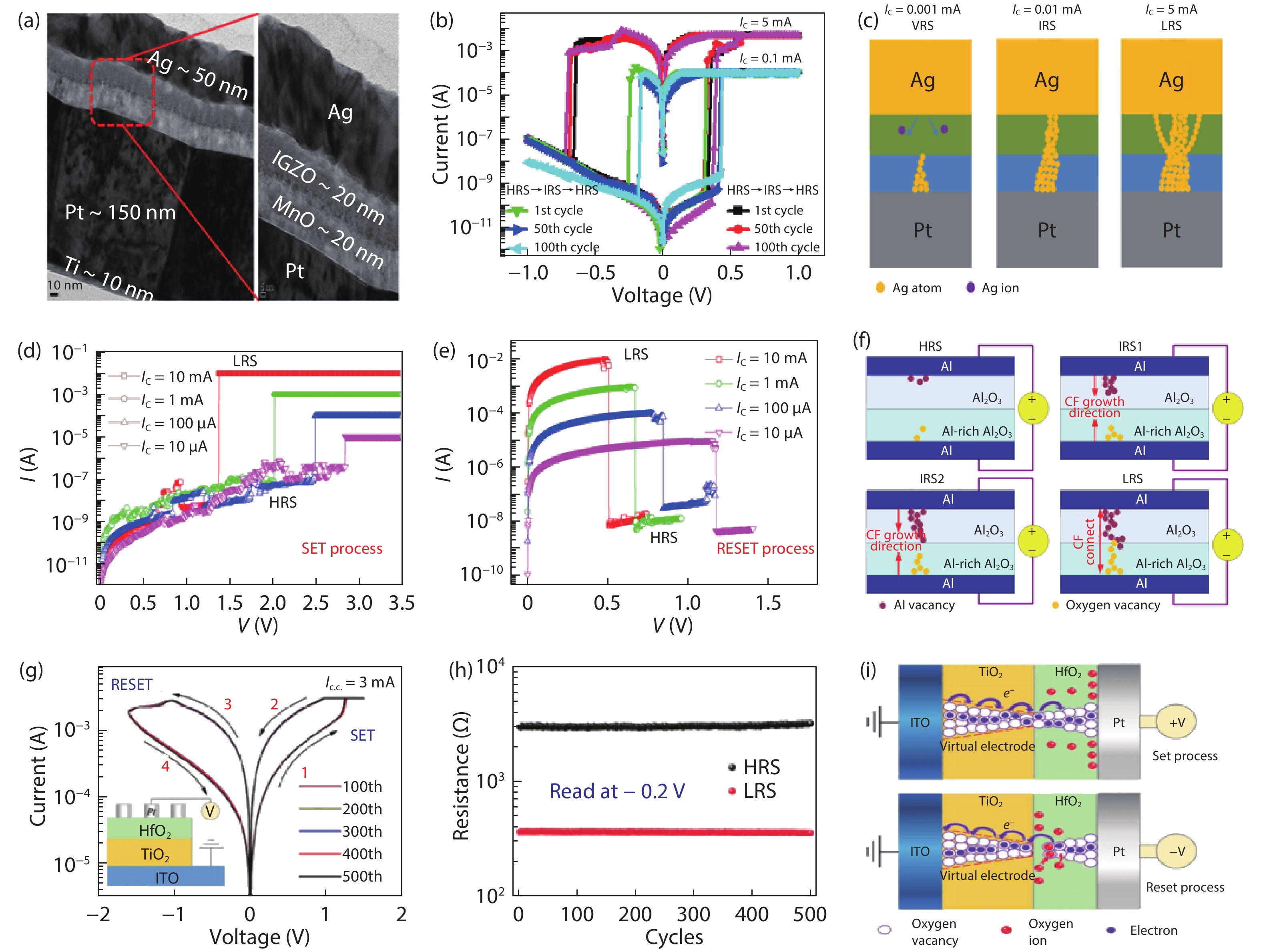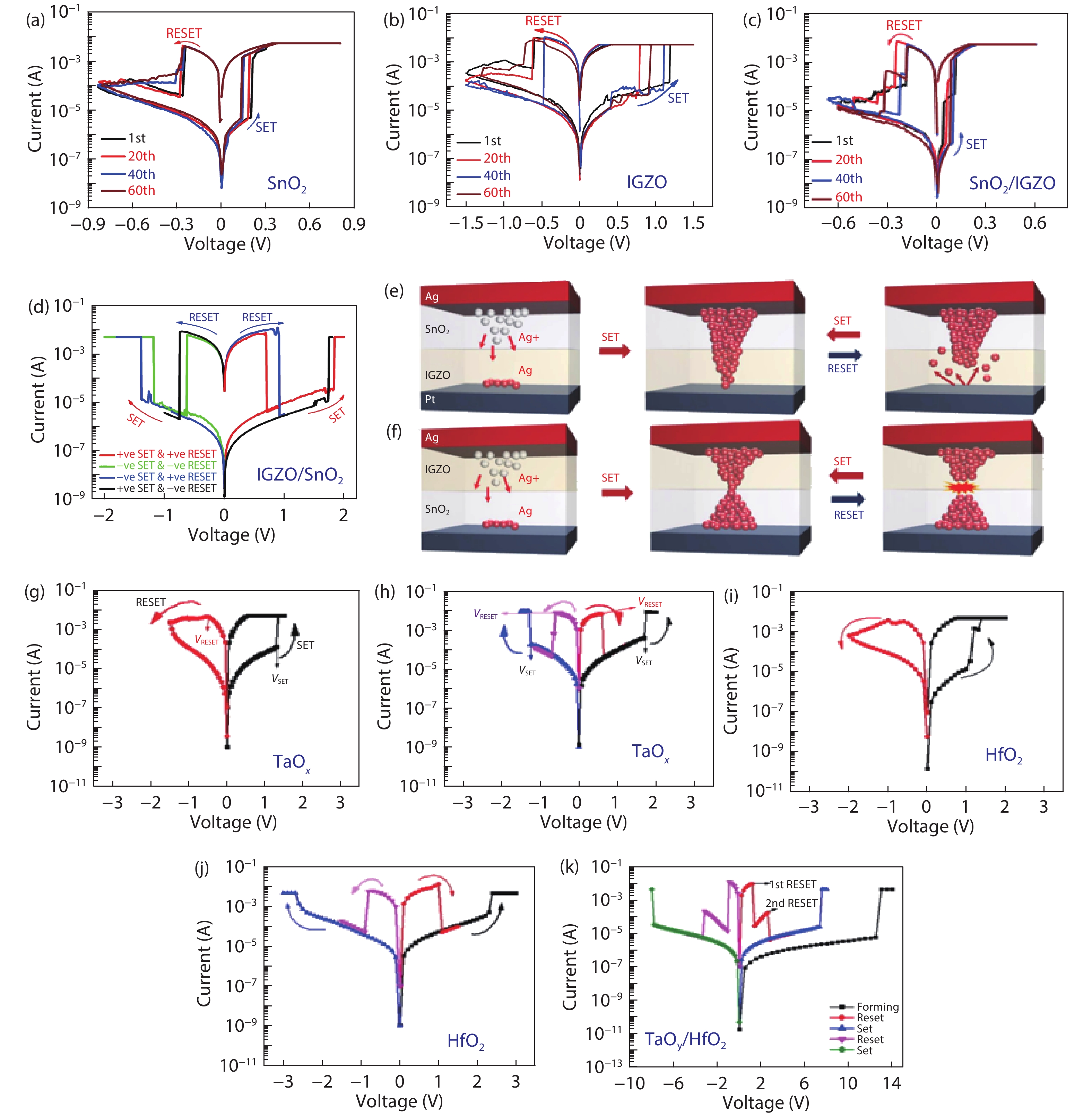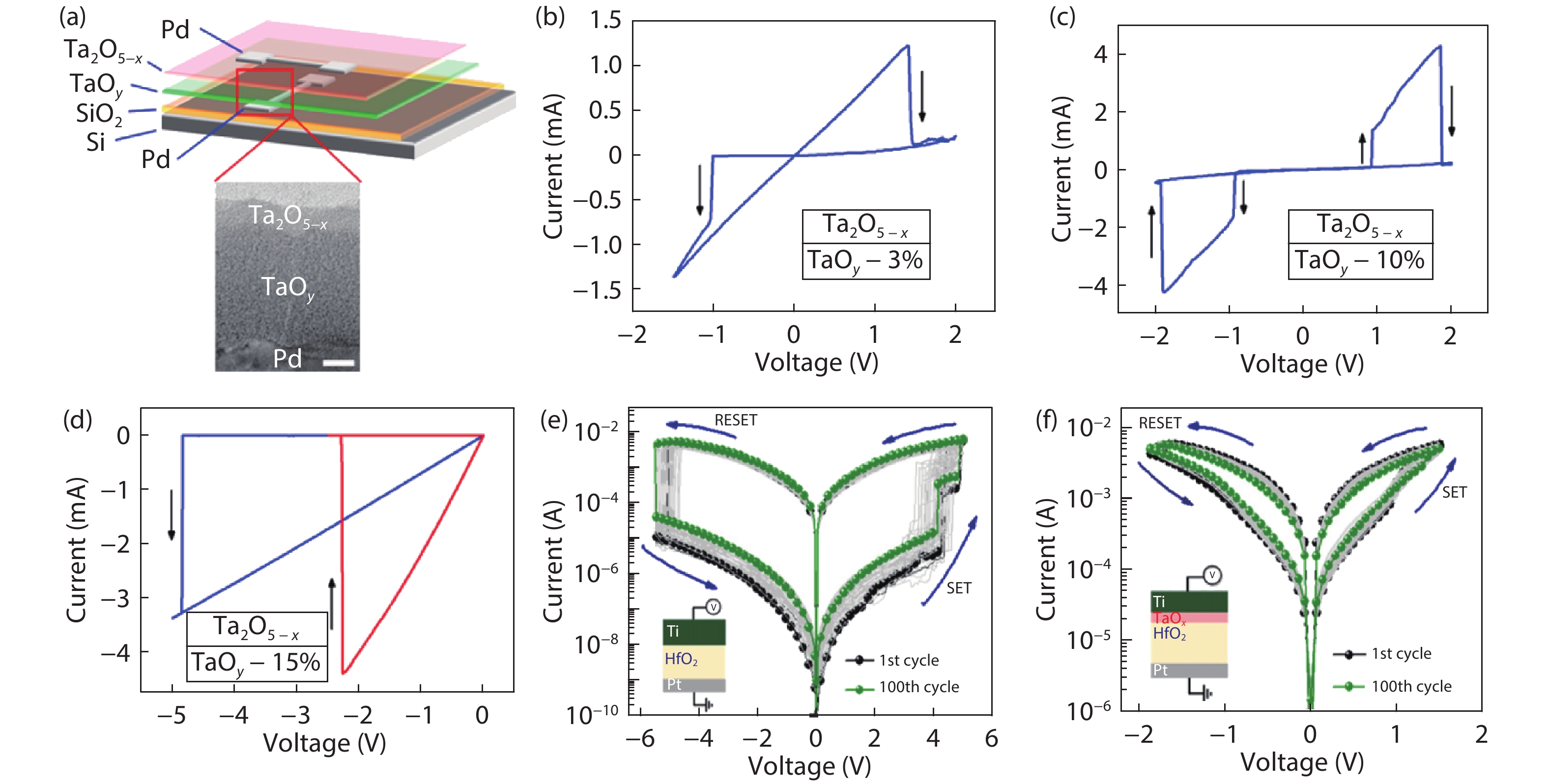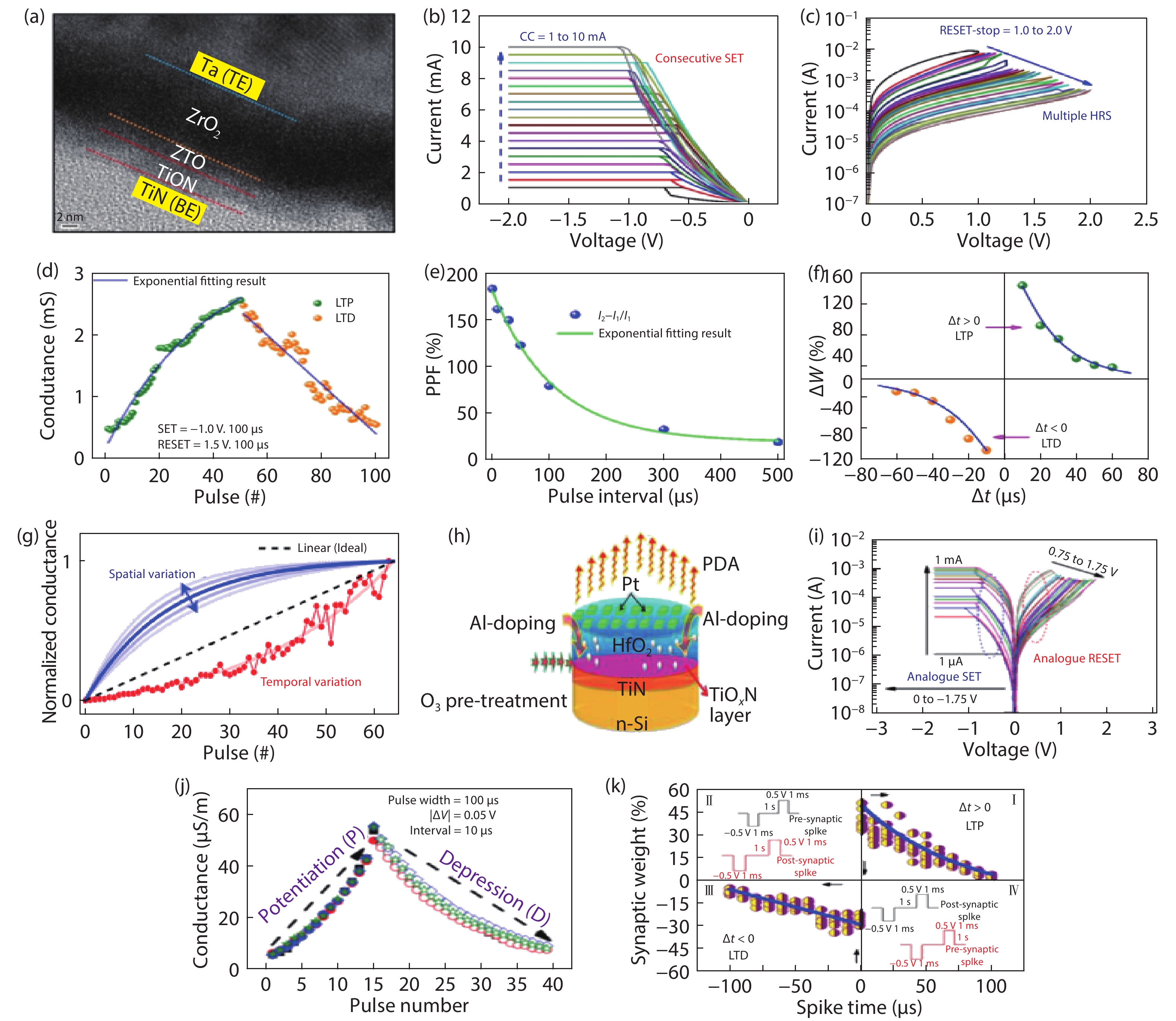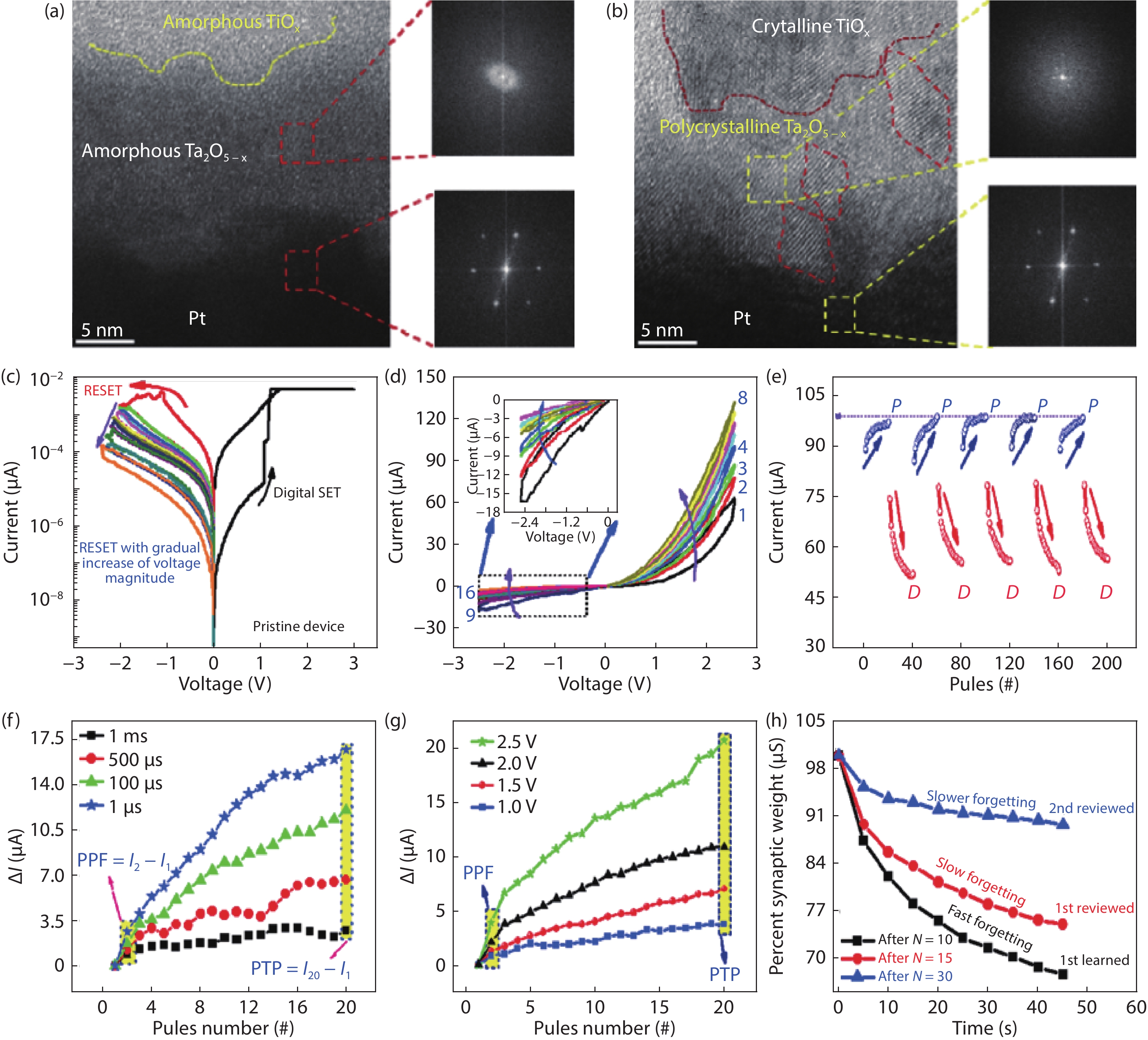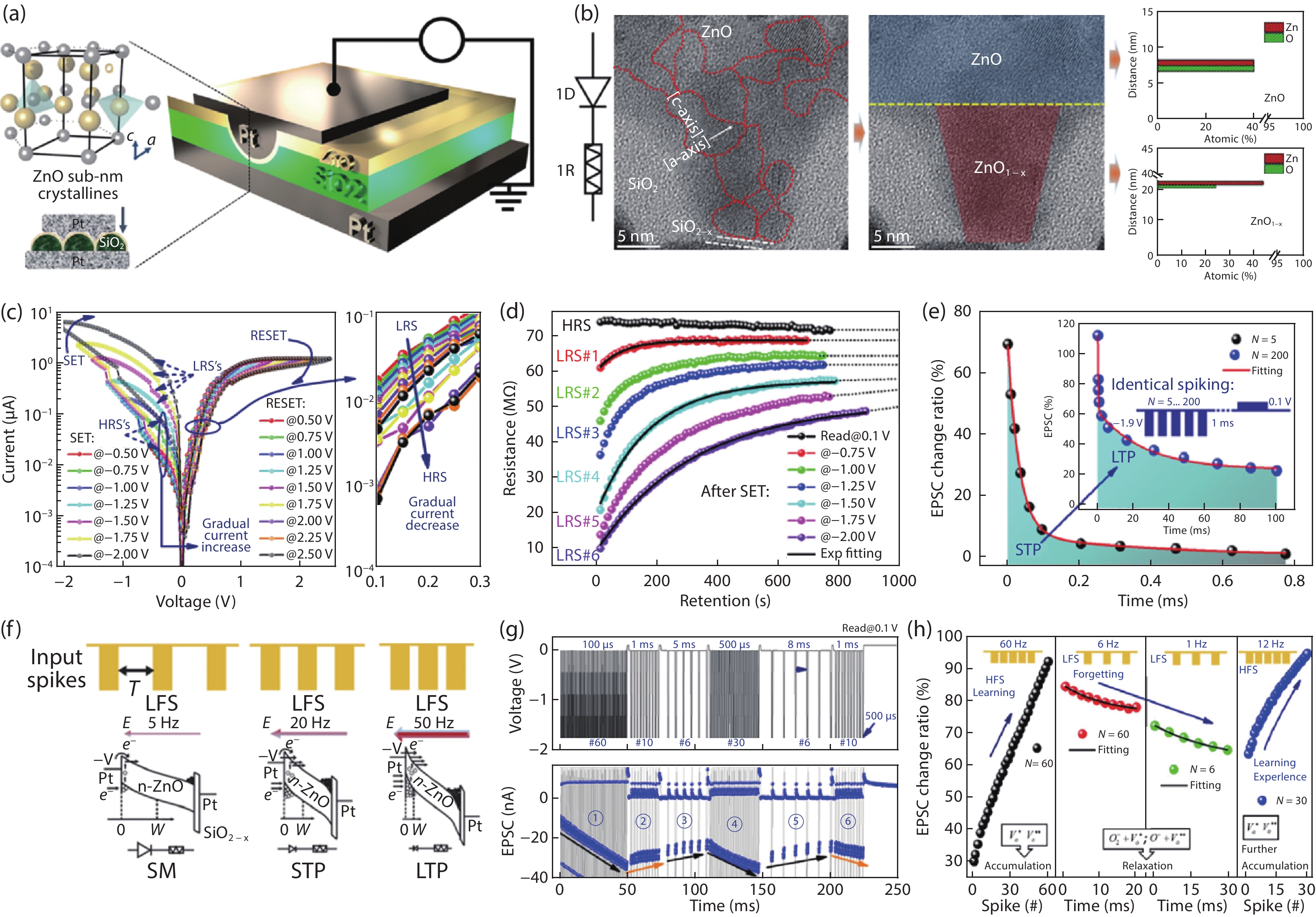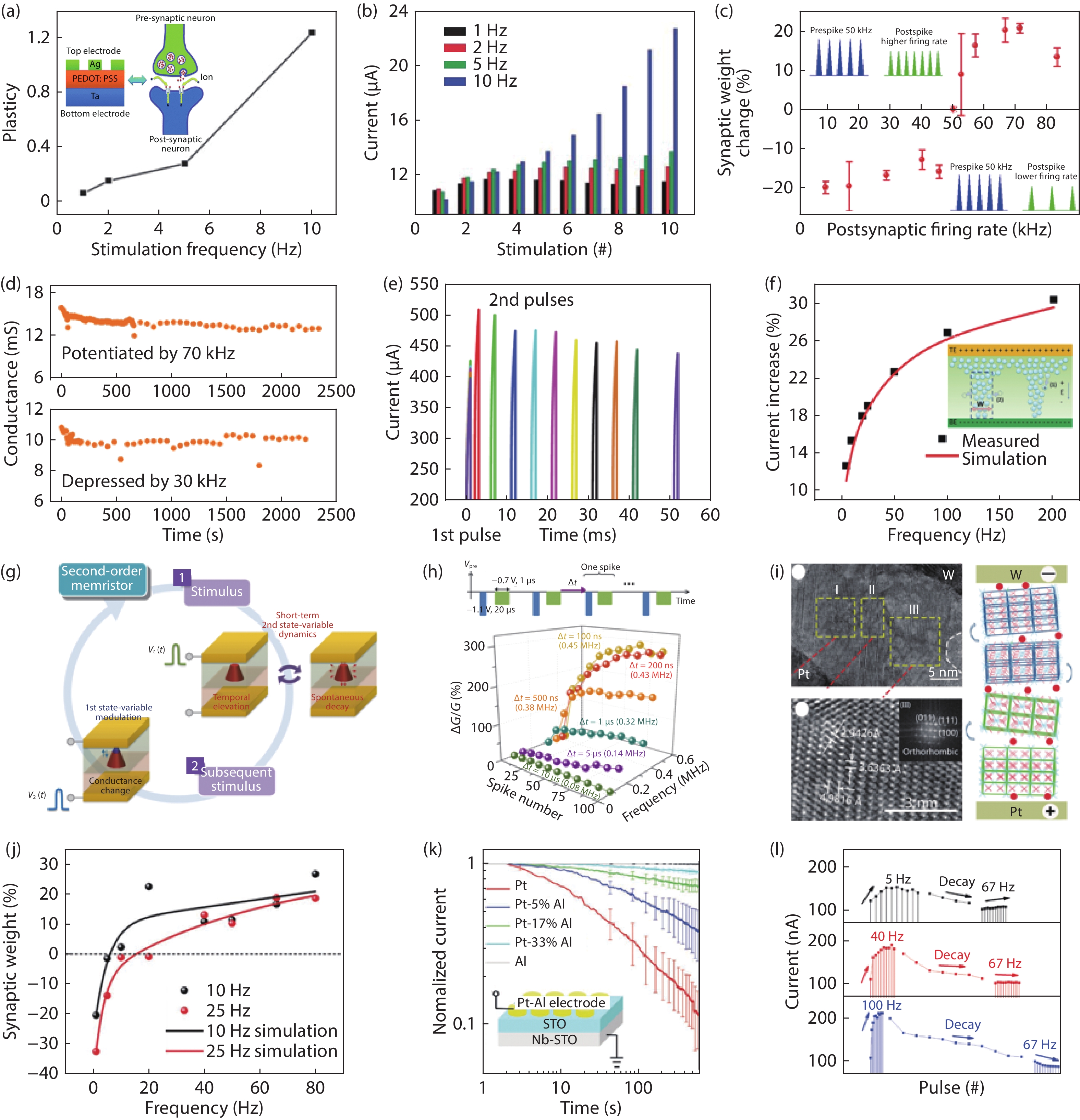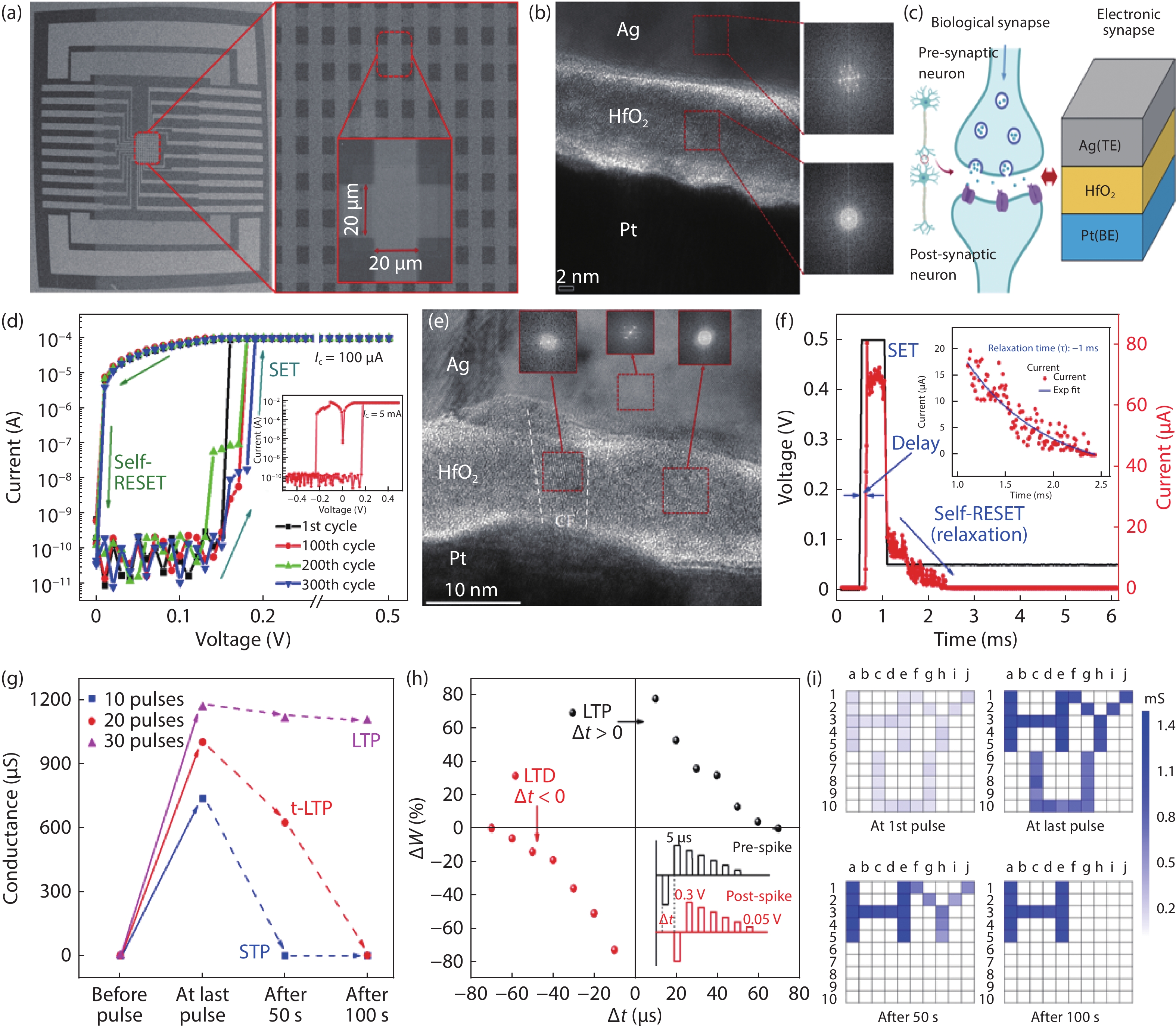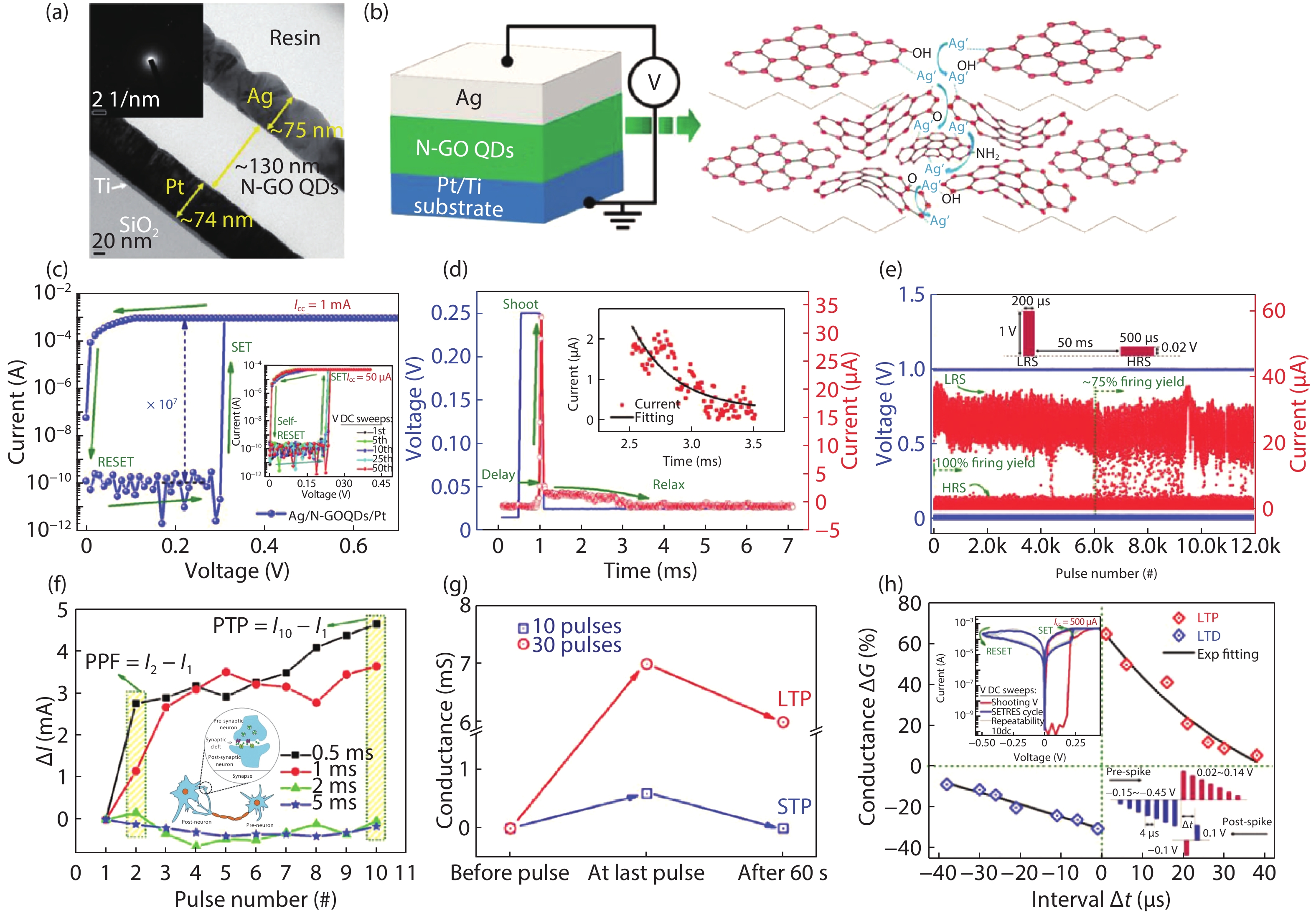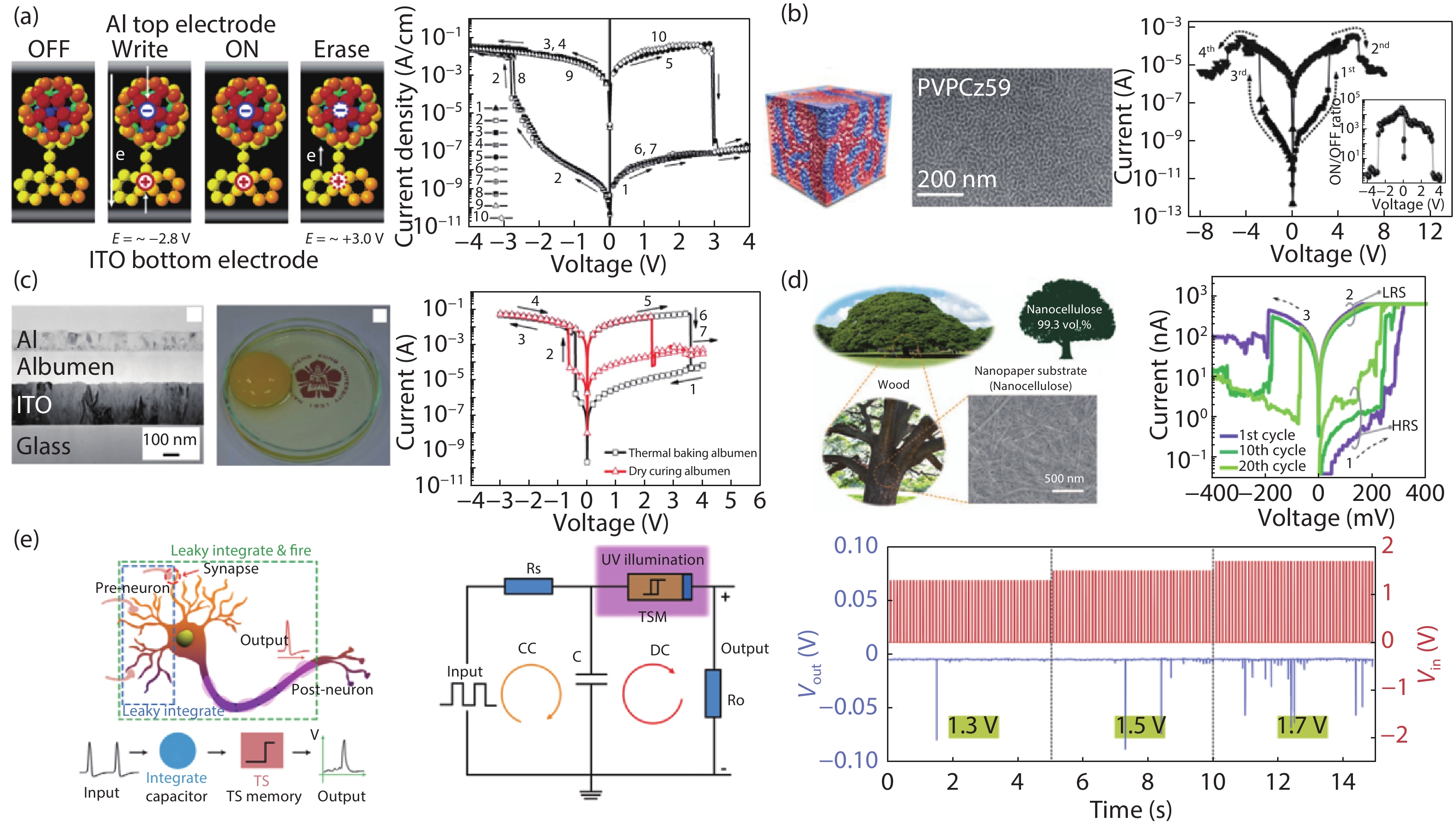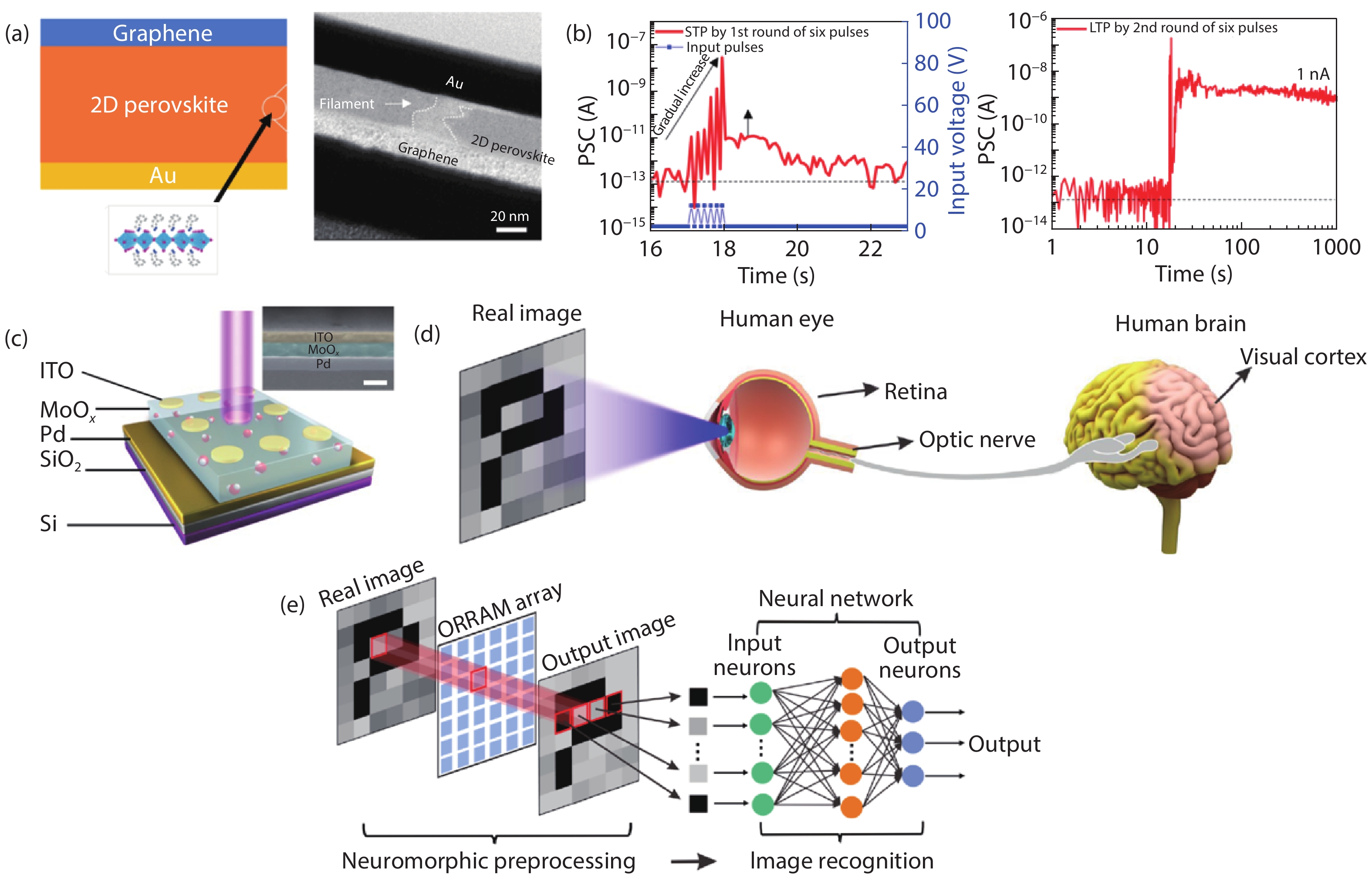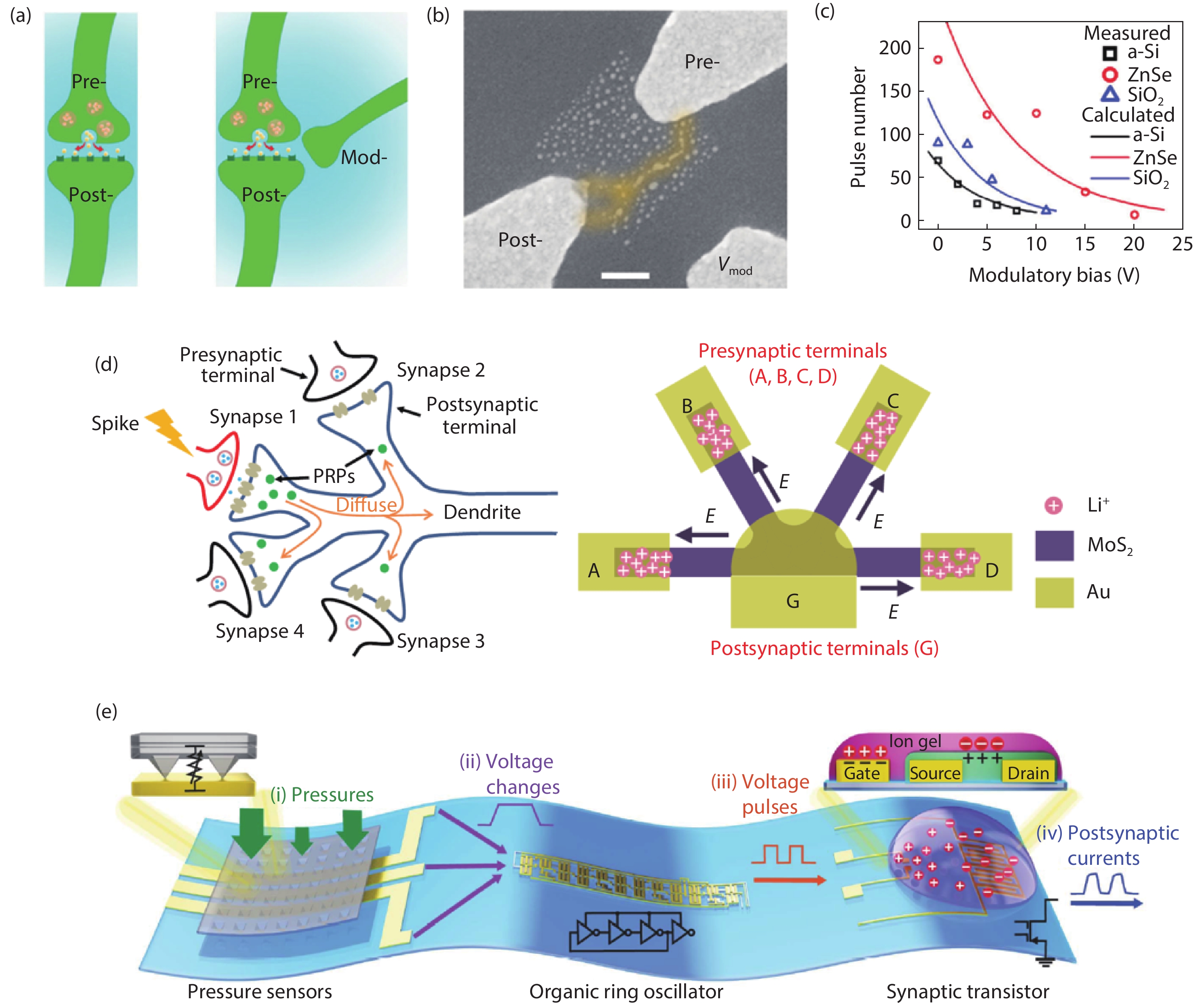| Citation: |
Andrey S. Sokolov, Haider Abbas, Yawar Abbas, Changhwan Choi. Towards engineering in memristors for emerging memory and neuromorphic computing: A review[J]. Journal of Semiconductors, 2021, 42(1): 013101. doi: 10.1088/1674-4926/42/1/013101
****
A S Sokolov, H Abbas, Y Abbas, C Choi, Towards engineering in memristors for emerging memory and neuromorphic computing: A review[J]. J. Semicond., 2021, 42(1): 013101. doi: 10.1088/1674-4926/42/1/013101.
|
Towards engineering in memristors for emerging memory and neuromorphic computing: A review
DOI: 10.1088/1674-4926/42/1/013101
More Information
-
Abstract
Resistive random-access memory (RRAM), also known as memristors, having a very simple device structure with two terminals, fulfill almost all of the fundamental requirements of volatile memory, nonvolatile memory, and neuromorphic characteristics. Its memory and neuromorphic behaviors are currently being explored in relation to a range of materials, such as biological materials, perovskites, 2D materials, and transition metal oxides. In this review, we discuss the different electrical behaviors exhibited by RRAM devices based on these materials by briefly explaining their corresponding switching mechanisms. We then discuss emergent memory technologies using memristors, together with its potential neuromorphic applications, by elucidating the different material engineering techniques used during device fabrication to improve the memory and neuromorphic performance of devices, in areas such as ION/IOFF ratio, endurance, spike time-dependent plasticity (STDP), and paired-pulse facilitation (PPF), among others. The emulation of essential biological synaptic functions realized in various switching materials, including inorganic metal oxides and new organic materials, as well as diverse device structures such as single-layer and multilayer hetero-structured devices, and crossbar arrays, is analyzed in detail. Finally, we discuss current challenges and future prospects for the development of inorganic and new materials-based memristors. -
References
[1] Zidan M A, Strachan J P, Lu W D. The future of electronics based on memristive systems. Nat Electron, 2018, 1, 22 doi: 10.1038/s41928-017-0006-8[2] Lee J, Lu W D. On-demand reconfiguration of nanomaterials: when electronics meets ionics. Adv Mater, 2018, 30, 1702770 doi: 10.1002/adma.201702770[3] Jun Z. Flash memory technology development. International Conference on Solid-State and Integrated Circuit Technology Proceedings, 2001, 1, 189[4] Wang H, Ren D, Lu C, et al. Investigation of multilayer WS2 flakes as charge trapping stack layers in non-volatile memories. Appl Phys Lett, 2018, 112, 231903 doi: 10.1063/1.5024799[5] Bez R, Camerlenghi E, Modelli A, et al. Introduction to flash memory. Proc IEEE, 2003, 91, 489 doi: 10.1109/JPROC.2003.811702[6] Lai S K. Flash memories: Successes and challenges. IBM J Resd Dev, 2008, 52, 529 doi: 10.1147/rd.524.0529[7] Lee M J, Lee C B, Lee D, et al. A fast, high-endurance and scalable non-volatile memory device made from asymmetric Ta2O5− x/TaO2− x bilayer structures. Nat Mater, 2011, 10, 625 doi: 10.1038/nmat3070[8] Wang H, Yan X. Overview of resistive random access memory (RRAM): Materials, filament mechanisms, performance optimization, and prospects. Phys Status Solidi (RRL), 2019, 13, 1900073 doi: 10.1002/pssr.201900073[9] Cao G, Cheng C, Zhang H, et al. The application of halide perovskites in memristors. J Semicond, 2020, 41, 051205 doi: 10.1088/1674-4926/41/5/051205[10] Meena J S, Sze S M, Chand U, et al. Overview of emerging nonvolatile memory technologies. Nanoscale Res Lett, 2014, 9, 526 doi: 10.1186/1556-276X-9-526[11] Ouyang J, Chu C W, Szmanda C R, et al. Programmable polymer thin film and non-volatile memory device. Nat Mater, 2004, 3, 918 doi: 10.1038/nmat1269[12] Tiwari S, Rana F, Chan K, et al. Volatile and non-volatile memories in silicon with nano-crystal storage. IEEE Int Electron Devices Meet, 1995, 521[13] Rezk A, Abbas Y, Saadat I, et al. Charging and discharging characteristics of a single gold nanoparticle embedded in Al2O3 thin films. Appl Phys Lett, 2020, 116, 223501 doi: 10.1063/5.0004000[14] Leong W L, Mathews N, Tan B, et al. Towards printable organic thin film transistor based flash memory devices. J Mater Chem, 2011, 21, 5203 doi: 10.1039/c0jm03974h[15] Baek B, Rippard W H, Benz S P, et al. Hybrid superconducting-magnetic memory device using competing order parameters. Nat Commun, 2014, 5, 3888 doi: 10.1038/ncomms4888[16] Dor O B, Yochelis S, Mathew S P, et al. A chiral-based magnetic memory device without a permanent magnet. Nat Commun, 2013, 4, 2256 doi: 10.1038/ncomms3256[17] Koelmans W W, Sebastian A, Jonnalagadda V P, et al. Projected phase-change memory devices. Nat Commun, 2015, 6, 213002 doi: 10.1038/ncomms9181[18] Simpson R, Fons P, Kolobov A, et al. Interfacial phase-change memory. Nat Nanotechnol, 2011, 6, 501 doi: 10.1038/nnano.2011.96[19] Chang T C, Chang K C, Tsai T M, et al. Resistance random access memory. Mater Today, 2016, 19, 254 doi: 10.1016/j.mattod.2015.11.009[20] Abbas Y, Park M R, Hu Q, et al. Resistive switching characteristics of tantalum oxide with different top electrodes. J Nanosci Nanotechnol, 2016, 16, 10231 doi: 10.1166/jnn.2016.13133[21] Abbas H, Park M R, Abbas Y, et al. Resistive switching characteristics of manganese oxide thin film and nanoparticle assembly hybrid devices. Jpn J Appl Phys, 2018, 57, 06HC03 doi: 10.7567/JJAP.57.06HC03[22] Mikolajick T, Dehm C, Hartner W, et al. FeRAM technology for high density applications. Microelectron Reliab, 2001, 41, 947 doi: 10.1016/S0026-2714(01)00049-X[23] Tehrani S, Slaughter J, Chen E, et al. Progress and outlook for MRAM technology. IEEE Trans Magnet, 1999, 35, 2814 doi: 10.1109/20.800991[24] Raoux S, Burr G W, Breitwisch M J, et al. Phase-change random access memory: A scalable technology. IBM J Resd Dev, 2008, 52, 465 doi: 10.1147/rd.524.0465[25] Wong H S P, Lee H Y, Yu S, et al. Metal–oxide RRAM. Proc IEEE, 2012, 100, 1951 doi: 10.1109/JPROC.2012.2190369[26] Seok J Y, Song S J, Yoon J H, et al. A review of three-dimensional resistive switching cross-bar array memories from the integration and materials property points of view. Adv Funct Mater, 2014, 24, 5316 doi: 10.1002/adfm.201303520[27] Zhu D, Li Y, Shen W, et al. Resistive random access memory and its applications in storage and nonvolatile logic. J Semicond, 2017, 38, 071002 doi: 10.1088/1674-4926/38/7/071002[28] Torrezan A C, Strachan J P, Medeiros-Ribeiro G, et al. Sub-nanosecond switching of a tantalum oxide memristor. Nanotechnology, 2011, 22, 485203 doi: 10.1088/0957-4484/22/48/485203[29] Jeon Y R, Abbas Y, Sokolov A S, et al. Study of in situ silver migration in amorphous boron nitride CBRAM device. ACS Appl Mater Interfaces, 2019, 11, 23329 doi: 10.1021/acsami.9b05384[30] Abbas Y, Ambade R B, Ambade S B, et al. Tailored nanoplateau and nanochannel structures using solution-processed rutile TiO2 thin films for complementary and bipolar switching characteristics. Nanoscale, 2019, 11, 13815 doi: 10.1039/C9NR03465J[31] Milo V, Zambelli C, Olivo P, et al. Multilevel HfO2-based RRAM devices for low-power neuromorphic networks. APL Mater, 2019, 7, 081120 doi: 10.1063/1.5108650[32] Ku B, Koo B, Sokolov A S, et al. Two-terminal artificial synapse with hybrid organic –inorganic perovskite (CH3NH3)PbI3 and low operating power energy (~ 47 fJ/μm2). J Alloys Compd, 2020, 833, 155064 doi: 10.1016/j.jallcom.2020.155064[33] Zahoor F, Azni Zulkifli T Z, Khanday F A. Resistive random access memory (RRAM): an overview of materials, switching mechanism, performance, multilevel cell (MLC) storage, modeling, and applications. Nanoscale Res Lett, 2020, 15, 1 doi: 10.1186/s11671-019-3237-y[34] Strukov D B, Snider G S, Stewart D R, et al. The missing memristor found. Nature, 2008, 453, 80 doi: 10.1038/nature06932[35] Xu C, Dong X, Jouppi N P, et al. Design implications of memristor-based RRAM cross-point structures. IEEE Design, Automation & Test in Europe, 2011, 1[36] Lee T S, Lee N J, Abbas H, et al. Compliance current-controlled conducting filament formation in tantalum oxide-based RRAM devices with different top electrodes. ACS Appl Electron Mater, 2020, 2, 1154 doi: 10.1021/acsaelm.0c00128[37] Abbas H, Ali A, Jung J, et al. Reversible transition of volatile to non-volatile resistive switching and compliance current-dependent multistate switching in IGZO/MnO RRAM devices. Appl Phys Lett, 2019, 114, 093503 doi: 10.1063/1.5082901[38] Abbas Y, Dugasani S R, Raza M T, et al. The observation of resistive switching characteristics using transparent and biocompatible Cu2+-doped salmon DNA composite thin film. Nanotechnology, 2019, 30, 335203 doi: 10.1088/1361-6528/ab1cfd[39] Lee J, Schell W, Zhu X J, et al. Charge transition of oxygen vacancies during resistive switching in oxide-based RRAM. ACS Appl Mater Interfaces, 2019, 11, 11579 doi: 10.1021/acsami.8b18386[40] Abbas Y, Jeon Y R, Sokolov A S, et al. Compliance-free, digital SET and analog RESET synaptic characteristics of sub-tantalum oxide based neuromorphic device. Sci Rep-Uk, 2018, 8, 1228 doi: 10.1038/s41598-018-19575-9[41] Sokolov A S, Jeon Y R, Kim S, et al. Influence of oxygen vacancies in ALD HfO2– x thin films on non-volatile resistive switching phenomena with a Ti/HfO2– x/Pt structure. Appl Surf Sci, 2018, 434, 822 doi: 10.1016/j.apsusc.2017.11.016[42] Kim H J, Park T H, Yoon K J, et al. Fabrication of a Cu-cone-shaped cation source inserted conductive bridge random access memory and its improved switching reliability. Adv Funct Mater, 2019, 29, 1806278 doi: 10.1002/adfm.201806278[43] Celano U, de Beeck J O, Clima S, et al. Direct probing of the dielectric scavenging-layer interface in oxide filamentary-based valence change memory. ACS Appl Mater Interfaces, 2017, 9, 10820 doi: 10.1021/acsami.6b16268[44] Zhao X L, Liu S, Niu J B, et al. Confining cation injection to enhance CBRAM performance by nanopore graphene layer. Small, 2017, 13, 1603948 doi: 10.1002/smll.201603948[45] Menzel S, Tappertzhofen S, Waser R, et al. Switching kinetics of electrochemical metallization memory cells. Phys Chem Chem Phys, 2013, 15, 6945 doi: 10.1039/c3cp50738f[46] Valov I, Waser R, Jameson J R, et al. Electrochemical metallization memories—fundamentals, applications, prospects. Nanotechnology, 2011, 22, 254003 doi: 10.1088/0957-4484/22/25/254003[47] Hsu C C and Lin Y S. Electrode dependence of resistive switching characteristics in copper (II) oxide memory devices. Semicond Sci Tech, 2019, 34, 075012 doi: 10.1088/1361-6641/ab1718[48] Ambrosi E, Bricalli A, Laudato M, et al. Impact of oxide and electrode materials on the switching characteristics of oxide ReRAM devices. Faraday Discuss, 2019, 213, 87 doi: 10.1039/C8FD00106E[49] Abbas H, Abbas Y, Hassan G, et al. The coexistence of threshold and memory switching characteristics of ALD HfO2 memristor synaptic arrays for energy-efficient neuromorphic computing. Nanoscale, 2020, 12, 14120 doi: 10.1039/D0NR02335C[50] Pei J, Deng L, Song S, et al. Towards artificial general intelligence with hybrid Tianjic chip architecture. Nature, 2019, 572, 106 doi: 10.1038/s41586-019-1424-8[51] Prezioso M, Merrikh-Bayat F, Hoskins B, et al. Training and operation of an integrated neuromorphic network based on metal-oxide memristors. Nature, 2015, 521, 61 doi: 10.1038/nature14441[52] Hansen M, Ziegler M, Kolberg L, et al. A double barrier memristive device. Sci Rep-Uk, 2015, 5, 13753 doi: 10.1038/srep13753[53] Sokolov A S, Son S K, Lim D, et al. Comparative study of Al2O3, HfO2, and HfAlO x for improved self-compliance bipolar resistive switching. J Am Ceram Soc, 2017, 100, 5638 doi: 10.1111/jace.15100[54] Waser R, Dittmann R, Staikov G, et al. Redox-based resistive switching memories–nanoionic mechanisms, prospects, and challenges. Adv Mater, 2009, 21, 2632 doi: 10.1002/adma.200900375[55] Sokolov A S, Jeon Y R, Kim S, et al. Bio-realistic synaptic characteristics in the cone-shaped ZnO memristive device. npg Asia Mater, 2019, 11, 5 doi: 10.1038/s41427-018-0105-7[56] Abbas Y, Sokolov A S, Jeon Y R, et al. Structural engineering of tantalum oxide based memristor and its electrical switching responses using rapid thermal annealing. J Alloys Compd, 2018, 759, 44 doi: 10.1016/j.jallcom.2018.05.106[57] Xiao Z, Huang J. Energy-efficient hybrid perovskite memristors and synaptic devices. Adv Electron Mater, 2016, 2, 1600100 doi: 10.1002/aelm.201600100[58] Ling Q D, Lim S L, Song Y, et al. Nonvolatile polymer memory device based on bistable electrical switching in a thin film of poly (N-vinylcarbazole) with covalently bonded C60. Langmuir, 2007, 23, 312 doi: 10.1021/la061504z[59] Chen Y, Liu G, Wang C, et al. Polymer memristor for information storage and neuromorphic applications. Mater Horiz, 2014, 1, 489 doi: 10.1039/C4MH00067F[60] Tian H, Zhao L, Wang X, et al. Extremely low operating current resistive memory based on exfoliated 2D perovskite single crystals for neuromorphic computing. Acs Nano, 2017, 11, 12247 doi: 10.1021/acsnano.7b05726[61] Wang M, Cai S, Pan C, et al. Robust memristors based on layered two-dimensional materials. Nat Electron, 2018, 1, 130 doi: 10.1038/s41928-018-0021-4[62] Zhou F, Zhou Z, Chen J, et al. Optoelectronic resistive random access memory for neuromorphic vision sensors. Nat Nanotechnol, 2019, 14, 776 doi: 10.1038/s41565-019-0501-3[63] Pan C, Wang C Y, Liang S J, et al. Reconfigurable logic and neuromorphic circuits based on electrically tunable two-dimensional homojunctions. Nat Electron, 2020, 3, 383 doi: 10.1038/s41928-020-0433-9[64] Wang C Y, Liang S J, Wang S, et al. Gate-tunable van der Waals heterostructure for reconfigurable neural network vision sensor. Sci Adv, 2020, 6, eaba6173 doi: 10.1126/sciadv.aba6173[65] Celano U, Nagashima K, Koga H, et al. All-nanocellulose nonvolatile resistive memory. npg Asia Mater, 2016, 8, e310 doi: 10.1038/am.2016.144[66] van De Burgt Y, Melianas A, Keene S T, et al. Organic electronics for neuromorphic computing. Nat Electron, 2018, 1, 386 doi: 10.1038/s41928-018-0103-3[67] Kim T H, Jang E Y, Lee N J, et al. Nanoparticle assemblies as memristors. Nano Lett, 2009, 9, 2229 doi: 10.1021/nl900030n[68] Wang Z, Wang L, Nagai M, et al. Nanoionics-enabled memristive devices: strategies and materials for neuromorphic applications. Adv Electron Mater, 2017, 3, 1600510 doi: 10.1002/aelm.201600510[69] Kim S G, Han J S, Kim H, et al. Recent advances in memristive materials for artificial synapses. Adv Mater Technol, 2018, 3, 1800457 doi: 10.1002/admt.201800457[70] Zhu X, Lee S H and Lu W D. Nanoionic resistive-switching devices. Adv Electron Mater, 2019, 5, 1900184 doi: 10.1002/aelm.201900184[71] Reina G, González-Domínguez J M, Criado A, et al. Promises, facts and challenges for graphene in biomedical applications. Chem Soc Rev, 2017, 46, 4400 doi: 10.1039/C7CS00363C[72] Zhou L, Mao J Y, Ren Y, et al. Biological spiking synapse constructed from solution processed bimetal core –shell nanoparticle based composites. Small, 2018, 14, 1800288 doi: 10.1002/smll.201800288[73] Sokolov A S, Ali M, Riaz R, et al. Silver-adapted diffusive memristor based on organic nitrogen-doped graphene oxide quantum dots (N-GOQDs) for artificial biosynapse applications. Adv Funct Mater, 2019, 29, 1807504 doi: 10.1002/adfm.201807504[74] Wang J, Lv Z, Xing X, et al. Optically modulated threshold switching in core –shell quantum dot based memristive device. Adv Funct Mater, 2020, 30, 1909114 doi: 10.1002/adfm.201909114[75] Yeon H, Lin P, Choi C, et al. Alloying conducting channels for reliable neuromorphic computing. Nat Nanotechnol, 2020, 15, 574 doi: 10.1038/s41565-020-0694-5[76] Li Z Y, Pickett M D, Stewart D, et al. Experimental demonstration of a defect-tolerant nanocrossbar demultiplexer. Nanotechnology, 2008, 19, 165203 doi: 10.1088/0957-4484/19/16/165203[77] Ku B, Abbas Y, Kim S, et al. Improved resistive switching and synaptic characteristics using Ar plasma irradiation on the Ti/HfO2 interface. J Alloys Compd, 2019, 797, 277 doi: 10.1016/j.jallcom.2019.05.114[78] Kang K, Ahn H, Song Y, et al. High-performance solution-processed organo-metal halide perovskite unipolar resistive memory devices in a cross-bar array structure. Adv Mater, 2019, 31, 1804841 doi: 10.1002/adma.201804841[79] Hu W, Zou L L, Lin X G, et al. Unipolar resistive switching effect and mechanism of solution-processed spinel Co3O4 thin films. Mater Des, 2016, 103, 230 doi: 10.1016/j.matdes.2016.04.070[80] Ali A, Abbas Y, Abbas H, et al. Dependence of InGaZnO and SnO2 thin film stacking sequence for the resistive switching characteristics of conductive bridge memory devices. Appl Surf Sci, 2020, 525, 146390 doi: 10.1016/j.apsusc.2020.146390[81] Wu S X, Li S W. Compliance current dependence of conversion between bipolar, unipolar, and threshold resistance switching in Mn3O4 films. AIP Adv, 2015, 5, 087154 doi: 10.1063/1.4929475[82] Ismail M, Ahmed E, Rana A M, et al. Coexistence of bipolar and unipolar resistive switching in Al-doped ceria thin films for non-volatile memory applications. J Alloys Compd, 2015, 646, 662 doi: 10.1016/j.jallcom.2015.06.146[83] Hosseini N R, Lee J S. Biocompatible and flexible chitosan-based resistive switching memory with magnesium electrodes. Adv Funct Mater, 2015, 25, 5586 doi: 10.1002/adfm.201502592[84] Bai Y, Wu H Q, Wu R G, et al. Study of multi-level characteristics for 3D vertical resistive switching memory. Sci Rep-Uk, 2014, 4, 5780 doi: 10.1038/srep05780[85] Sawa A. Resistive switching in transition metal oxides. Mater Today, 2008, 11, 28 doi: 10.1016/S1369-7021(08)70119-6[86] Baek K, Park S, Park J, et al. In situ TEM observation on the interface-type resistive switching by electrochemical redox reactions at a TiN/PCMO interface. Nanoscale, 2017, 9, 582 doi: 10.1039/C6NR06293H[87] You T G, Ou X, Niu G, et al. Engineering interface-type resistive switching in BiFeO3 thin film switches by Ti implantation of bottom electrodes. Sci Rep-Uk, 2015, 5, 18623 doi: 10.1038/srep18623[88] Abbas H, Abbas Y, Truong S N, et al. A memristor crossbar array of titanium oxide for non-volatile memory and neuromorphic applications. Semicond Sci Tech, 2017, 32, 065014 doi: 10.1088/1361-6641/aa6a3a[89] Linn E, Rosezin R, Kugeler C, et al. Complementary resistive switches for passive nanocrossbar memories. Nat Mater, 2010, 9, 403 doi: 10.1038/nmat2748[90] Yang Y C, Sheridan P, Lu W. Complementary resistive switching in tantalum oxide-based resistive memory devices. Appl Phys Lett, 2012, 100, 203112 doi: 10.1063/1.4719198[91] Park Y, Lee J S. Artificial synapses with short- and long-term memory for spiking neural networks based on renewable materials. Acs Nano, 2017, 11, 8962 doi: 10.1021/acsnano.7b03347[92] Du C, Ma W, Chang T, et al. Biorealistic implementation of synaptic functions with oxide memristors through internal ionic dynamics. Adv Funct Mater, 2015, 25, 4290 doi: 10.1002/adfm.201501427[93] Chang T, Jo S H, Kim K H, et al. Synaptic behaviors and modeling of a metal oxide memristive device. Appl Phys A, 2011, 102, 857 doi: 10.1007/s00339-011-6296-1[94] Jo S H, Chang T, Ebong I, et al. Nanoscale memristor device as synapse in neuromorphic systems. Nano Lett, 2010, 10, 1297 doi: 10.1021/nl904092h[95] Sun H T, Liu Q, Li C F, et al. Direct observation of conversion between threshold switching and memory switching induced by conductive filament morphology. Adv Funct Mater, 2014, 24, 5679 doi: 10.1002/adfm.201401304[96] Wang Z R, Rao M Y, Midya R, et al. Threshold switching of Ag or Cu in dielectrics: Materials, mechanism, and applications. Adv Funct Mater, 2018, 28, 1704862 doi: 10.1002/adfm.201704862[97] Wang Z, Joshi S, Savel’ev S E, et al. Memristors with diffusive dynamics as synaptic emulators for neuromorphic computing. Nat Mater, 2017, 16, 101 doi: 10.1038/nmat4756[98] Ohno T, Hasegawa T, Tsuruoka T, et al. Short-term plasticity and long-term potentiation mimicked in single inorganic synapses. Nat Mater, 2011, 10, 591 doi: 10.1038/nmat3054[99] La Barbera S, Vuillaume D, Alibart F. Filamentary switching: synaptic plasticity through device volatility. Acs Nano, 2015, 9, 941 doi: 10.1021/nn506735m[100] Valov I, Staikov G. Nucleation and growth phenomena in nanosized electrochemical systems for resistive switching memories. J Solid State Electr, 2013, 17, 365 doi: 10.1007/s10008-012-1890-5[101] van den Hurk J, Linn E, Zhang H H, et al. Volatile resistance states in electrochemical metallization cells enabling non-destructive readout of complementary resistive switches. Nanotechnology, 2014, 25, 425202 doi: 10.1088/0957-4484/25/42/425202[102] Guzman D M, Onofrio N, Strachan A. Stability and migration of small copper clusters in amorphous dielectrics. J Appl Phys, 2015, 117, 195702 doi: 10.1063/1.4921059[103] Park Y, Kim M K, Lee J S. Emerging memory devices for artificial synapses. J Mater Chem C, 2020, 8, 9163 doi: 10.1039/D0TC01500H[104] Upadhyay N K, Jiang H, Wang Z, et al. Emerging memory devices for neuromorphic computing. Adv Mater Technol, 2019, 4, 1800589 doi: 10.1002/admt.201800589[105] Bi G Q, Poo M M. Synaptic modifications in cultured hippocampal neurons: dependence on spike timing, synaptic strength, and postsynaptic cell type. J Neurosci, 1998, 18, 10464 doi: 10.1523/JNEUROSCI.18-24-10464.1998[106] Ismail M, Abbas H, Choi C, et al. Controllable analog resistive switching and synaptic characteristics in ZrO2/ZTO bilayer memristive device for neuromorphic systems. Appl Surf Sci, 2020, 529, 147107 doi: 10.1016/j.apsusc.2020.147107[107] Wang R, Wu J. Structure and basic properties of ternary metal oxides and their prospects for application in supercapacitors. Met Oxides Supercapacit, 2017, 99[108] Faita F L, Silva J P B, Pereira M, et al. Enhanced resistive switching and multilevel behavior in bilayered HfAlO/HfAlO x structures for non-volatile memory applications. Appl Phys Lett, 2015, 107, 242105 doi: 10.1063/1.4937801[109] Wang S F, Tsai Y T, Chu J P. Resistive switching characteristics of a spinel ZnAl2O4 thin film prepared by radio frequency sputtering. Ceram Int, 2016, 42, 17673 doi: 10.1016/j.ceramint.2016.08.085[110] Katiyar R K, Sharma Y, Diestra D G B, et al. Unipolar resistive switching in planar Pt/BiFeO3/Pt structure. Aip Adv, 2015, 5, 037109 doi: 10.1063/1.4914475[111] Wu S X, Luo X, Turner S, et al. Nonvolatile resistive switching in Pt/LaAlO3/SrTiO3 heterostructures. Phys Rev X, 2013, 3, 041027 doi: 10.1103/PhysRevX.3.041027[112] Kwon D H, Lee S, Kang C S, et al. Unraveling the origin and mechanism of nanofilament formation in polycrystalline SrTiO3 resistive switching memories. Adv Mater, 2019, 31, 1901322 doi: 10.1002/adma.201901322[113] Hu Q, Huang A P, Zhang X J, et al. Modulation of resistive switching in Pt/LiCoO2/SiO2/Si stacks. J Mater Sci-Mater Electron, 2019, 30, 4753 doi: 10.1007/s10854-019-00768-5[114] Bhatnagar A, Chaudhuri A R, Kim Y H, et al. Role of domain walls in the abnormal photovoltaic effect in BiFeO3. Nat Commun, 2013, 4, 2835 doi: 10.1038/ncomms3835[115] Sulzbach M C, Estandia S, Gazquez J, et al. Blocking of conducting channels widens window for ferroelectric resistive switching in interface-engineered Hf0.5Zr0.5O2 tunnel devices. Adv Funct Mater, 2020, 30, 2002638 doi: 10.1002/adfm.202002638[116] Schweiger S, Pfenninger R, Bowman W J, et al. Designing strained interface heterostructures for memristive devices. Adv Mater, 2017, 29, 1605049 doi: 10.1002/adma.201605049[117] Maas K, Villepreux E, Cooper D, et al. Using a mixed ionic electronic conductor to build an analog memristive device with neuromorphic programming capabilities. J Mater Chem C, 2020, 8, 464 doi: 10.1039/C9TC03972D[118] Zhu J D, Zhang T, Yang Y C, et al. A comprehensive review on emerging artificial neuromorphic devices. Appl Phys Rev, 2020, 7, 011312 doi: 10.1063/1.5118217[119] Lee J S, Lee S, Noh T W. Resistive switching phenomena: A review of statistical physics approaches. Appl Phys Rev, 2015, 2, 031303 doi: 10.1063/1.4929512[120] Traore B, Blaise P, Vianello E, et al. On the origin of low-resistance state retention failure in HfO2-based RRAM and impact of doping/alloying. IEEE Trans Electron Devices, 2015, 62, 4029 doi: 10.1109/TED.2015.2490545[121] Zhang H W, Liu L F, Gao B, et al. Gd-doping effect on performance of HfO2 based resistive switching memory devices using implantation approach. Appl Phys Lett, 2011, 98, 042105 doi: 10.1063/1.3543837[122] Kim J, Na H, Lee S, et al. Reproducible resistance switching of defect-engineered NiO x with metallic Nb impurity. Thin Solid Films, 2011, 519, 8119 doi: 10.1016/j.tsf.2011.05.074[123] Jung K, Choi J, Kim Y, et al. Resistance switching characteristics in Li-doped NiO. J Appl Phys, 2008, 103, 034504 doi: 10.1063/1.2837102[124] Zhang H W, Gao B, Sun B, et al. Ionic doping effect in ZrO2 resistive switching memory. Appl Phys Lett, 2010, 96, 123502 doi: 10.1063/1.3364130[125] Wang Y, Liu Q, Long S B, et al. Investigation of resistive switching in Cu-doped HfO2 thin film for multilevel non-volatile memory applications. Nanotechnology, 2010, 21, 045202 doi: 10.1088/0957-4484/21/4/045202[126] Chang W Y, Cheng K J, Tsai J M, et al. Improvement of resistive switching characteristics in TiO2 thin films with embedded Pt nanocrystals. Appl Phys Lett, 2009, 95, 042104 doi: 10.1063/1.3193656[127] Sokolov A S, Jeon Y R, Ku B, et al. Ar ion plasma surface modification on the heterostructured TaOx/InGaZnO thin films for flexible memristor synapse. J Alloys Compd, 2020, 822, 153625 doi: 10.1016/j.jallcom.2019.153625[128] Wang J Y, Li L Z, Huyan H X, et al. Highly uniform resistive switching in HfO2 films embedded with ordered metal nanoisland arrays. Adv Funct Mater, 2019, 29, 1808430 doi: 10.1002/adfm.201808430[129] Kim S, Choi S, Lee J, et al. Tuning resistive switching characteristics of tantalum oxide memristors through Si doping. Acs Nano, 2014, 8, 10262 doi: 10.1021/nn503464q[130] Yan X B, Zhao J H, Liu S, et al. Memristor with Ag-cluster-doped TiO2 films as artificial synapse for neuroinspired computing. Adv Funct Mater, 2018, 28, 1705320 doi: 10.1002/adfm.201705320[131] Rehman S, Kim H, Khan M F, et al. Tuning of ionic mobility to improve the resistive switching behavior of Zn-doped CeO2. Sci Rep-Uk, 2019, 9, 19387 doi: 10.1038/s41598-019-55716-4[132] Wu Q T, Banerjee W, Cao J C, et al. Improvement of durability and switching speed by incorporating nanocrystals in the HfO x based resistive random access memory devices. Appl Phys Lett, 2018, 113, 023105 doi: 10.1063/1.5030780[133] Li L, Chang K C, Ye C, et al. An indirect way to achieve comprehensive performance improvement of resistive memory: when hafnium meets ITO in an electrode. Nanoscale, 2020, 12, 3267 doi: 10.1039/C9NR08943H[134] Kumar D, Chand U, Siang L W, et al. High-performance TiN/Al2O3/ZnO/Al2O3/TiN flexible RRAM device with high bending condition. IEEE Trans Electron Dev, 2020, 67, 493 doi: 10.1109/TED.2019.2959883[135] Mikhaylov A, Belov A, Korolev D, et al. Multilayer metal-oxide memristive device with stabilized resistive switching. Adv Mater Technol, 2020, 5, 1900607 doi: 10.1002/admt.201900607[136] Hu Q L, Abbas H, Kang T S, et al. Forming-free resistive switching characteristics in manganese oxide and hafnium oxide devices. Jpn J Appl Phys, 2019, 58, 044001 doi: 10.7567/1347-4065/ab01f8[137] Huang X D, Li Y, Li H Y, et al. Forming-free, fast, uniform, and high endurance resistive switching from cryogenic to high temperatures in W/AlO x/Al2O3/Pt bilayer memristor. IEEE Electron Device Lett, 2020, 41, 549 doi: 10.1109/LED.2020.2977397[138] Huang X D, Li Y, Li H Y, et al. Enhancement of DC/AC resistive switching performance in AlOx memristor by two-technique bilayer approach. Appl Phys Lett, 2020, 116, 173504 doi: 10.1063/5.0006850[139] Yin J, Zeng F, Wan Q, et al. Adaptive crystallite kinetics in homogenous bilayer oxide memristor for emulating diverse synaptic plasticity. Adv Funct Mater, 2018, 28, 1706927 doi: 10.1002/adfm.201706927[140] Chen W J, Cheng C H, Lin P E, et al. Analog resistive switching and synaptic functions in WO x/TaO x bilayer through redox-induced trap-controlled conduction. Acs Appl Electron Mater, 2019, 1, 2422 doi: 10.1021/acsaelm.9b00572[141] Liu H C, Tang X G, Liu Q X, et al. Bipolar resistive switching behavior and conduction mechanisms of composite nanostructured TiO2/ZrO2 thin film. Ceram Int, 2020, 46, 21196 doi: 10.1016/j.ceramint.2020.05.201[142] Srivastava S, Thomas J P, Leung K T. Programmable, electroforming-free TiO x/TaO x heterojunction-based non-volatile memory devices. Nanoscale, 2019, 11, 18159 doi: 10.1039/C9NR06403F[143] Siddik A, Haider P K, Garu P, et al. Enhancement of data storage capability in a bilayer oxide-based memristor for wearable electronic applications. J Phys D, 2020, 53, 295103 doi: 10.1088/1361-6463/ab81d3[144] Zhu W, Li J, Xu X, et al. Low power and ultrafast multi-state switching in nc-Al Induced Al2O3/Al xO y bilayer thin film RRAM device. IEEE Access, 2020, 8, 16310 doi: 10.1109/ACCESS.2020.2966026[145] Zhang R L, Huang H, Xia Q, et al. Role of oxygen vacancies at the TiO2/HfO2 interface in flexible oxide-based resistive switching memory. Adv Electron Mater, 2019, 5, 1800833 doi: 10.1002/aelm.201800833[146] Yang Y C, Choi S, Lu W. Oxide heterostructure resistive memory. Nano Lett, 2013, 13, 2908 doi: 10.1021/nl401287w[147] Lin J Y, Wu K Y, Chen K H. Effects of Sm2O3 and V2O5 film stacking on switching behaviors of resistive random access memories. Crystals, 2019, 9, 318 doi: 10.3390/cryst9060318[148] Wang C, Wu H Q, Gao B, et al. Conduction mechanisms, dynamics and stability in ReRAMs. Microelectron Eng, 2018, 187, 121 doi: 10.1016/j.mee.2017.11.003[149] Park M R, Abbas Y, Abbas H, et al. Resistive switching characteristics in hafnium oxide, tantalum oxide and bilayer devices. Microelectron Eng, 2016, 159, 190 doi: 10.1016/j.mee.2016.03.043[150] Kim S, Abbas Y, Jeon Y R, et al. Engineering synaptic characteristics of TaO x/HfO2 bi-layered resistive switching device. Nanotechnology, 2018, 29, 415204 doi: 10.1088/1361-6528/aad64c[151] Zhang H Z, Ju X, Yew K S, et al. Implementation of simple but powerful trilayer oxide-based artificial synapses with a tailored bio-synapse-like structure. ACS Appl Mater Interfaces, 2020, 12, 1036 doi: 10.1021/acsami.9b17026[152] Yan X B, Wang J J, Zhao M L, et al. Artificial electronic synapse characteristics of a Ta/Ta2O5– x/Al2O3/InGaZnO4 memristor device on flexible stainless steel substrate. Appl Phys Lett, 2018, 113, 013503 doi: 10.1063/1.5027776[153] Wu W, Wu H Q, Gao B, et al. Improving analog switching in HfO x-based resistive memory with a thermal enhanced layer. IEEE Electron Device Lett, 2017, 38, 1019 doi: 10.1109/LED.2017.2719161[154] Li D Y, Ilyas N, Li C M, et al. Synaptic learning and memory functions in SiO2:Ag/TiO2 based memristor devices. J Phys D, 2020, 53, 175102 doi: 10.1088/1361-6463/ab70c9[155] Kim H J, Kim M, Beom K, et al. A Pt/ITO/CeO2/Pt memristor with an analog, linear, symmetric, and long-term stable synaptic weight modulation. APL Mater, 2019, 7, 071113 doi: 10.1063/1.5097317[156] Chandrasekaran S, Simanjuntak F M, Saminathan R, et al. Improving linearity by introducing Al in HfO2 as a memristor synapse device. Nanotechnology, 2019, 30, 445205 doi: 10.1088/1361-6528/ab3480[157] Zhao M R, Gao B, Tang J S, et al. Reliability of analog resistive switching memory for neuromorphic computing. Appl Phys Rev, 2020, 7, 011301 doi: 10.1063/1.5124915[158] Roy S, Niu G, Wang Q, et al. Toward a reliable synaptic simulation using Al-doped HfO2 RRAM. ACS Appl Mater Interfaces, 2020, 12, 10648 doi: 10.1021/acsami.9b21530[159] Tulving E. Ebbinghaus memory - What did he learn and remember. J Exp Psychol Learn, 1985, 11, 485 doi: 10.1037/0278-7393.11.3.485[160] Yang R, Huang H M, Guo X. Memristive synapses and neurons for bioinspired computing. Adv Electron Mater, 2019, 5, 1900287 doi: 10.1002/aelm.201900287[161] Deutch A Y. Neuroscience: Exploring the brain. J Clin Psychiat, 1999, 60, 59 doi: 10.4088/JCP.v60n0113c[162] Bienenstock E L, Cooper L N, Munro P W. Theory for the development of neuron selectivity: orientation specificity and binocular interaction in visual cortex. J Neurosci, 1982, 2, 32 doi: 10.1523/JNEUROSCI.02-01-00032.1982[163] Huang Y J, Chao S C, Lien D H, et al. Dual-functional memory and threshold resistive switching based on the push-pull mechanism of oxygen ions. Sci Rep-Uk, 2016, 6, 23945 doi: 10.1038/srep23945[164] Ling H, Yi M D, Nagai M, et al. Controllable organic resistive switching achieved by one-step integration of cone-shaped contact. Adv Mater, 2017, 29, 1701333 doi: 10.1002/adma.201701333[165] Russo P, Xiao M, Liang R, et al. UV-induced multilevel current amplification memory effect in zinc oxide rods resistive switching devices. Adv Funct Mater, 2018, 28, 1706230 doi: 10.1002/adfm.201706230[166] Li S Z, Zeng F, Chen C, et al. Synaptic plasticity and learning behaviours mimicked through Ag interface movement in an Ag/conducting polymer/Ta memristive system. J Mater Chem C, 2013, 1, 5292 doi: 10.1039/c3tc30575a[167] Li Y, Zhong Y P, Zhang J J, et al. Activity-dependent synaptic plasticity of a chalcogenide electronic synapse for neuromorphic systems. Sci Rep-Uk, 2014, 4, 4906 doi: 10.1038/srep04906[168] Kim S, Du C, Sheridan P, et al. Experimental demonstration of a second-order memristor and its ability to biorealistically implement synaptic plasticity. Nano Lett, 2015, 15, 2203 doi: 10.1021/acs.nanolett.5b00697[169] Xiong J, Yang R, Shaibo J, et al. Bienenstock, Cooper, and Munro learning rules realized in second-order memristors with tunable forgetting rate. Adv Funct Mater, 2019, 29, 1807316 doi: 10.1002/adfm.201807316[170] Wang W, Bricalli A, Laudato M, et al. Physics-based modeling of volatile resistive switching memory (RRAM) for crosspoint selector and neuromorphic computing. IEEE Int Electron Devices Meet, 2018, 40.3.1[171] Xia Q, Yang J J. Memristive crossbar arrays for brain-inspired computing. Nat Mater, 2019, 18, 309 doi: 10.1038/s41563-019-0291-x[172] Truong S N, Ham S J, Min K S. Neuromorphic crossbar circuit with nanoscale filamentary-switching binary memristors for speech recognition. Nanoscale Res Lett, 2014, 9, 1 doi: 10.1186/1556-276X-9-1[173] Naous R, Al-Shedivat M, Neftci E, et al. Stochastic synaptic plasticity with memristor crossbar arrays. IEEE Int Symposium on Circuits and Systems, 2016, 2078[174] Truong S N. Single crossbar array of memristors with bipolar inputs for neuromorphic image recognition. IEEE Access, 2020, 8, 69327 doi: 10.1109/ACCESS.2020.2986513[175] Atkinson R C, Shiffrin R M. Human memory: A proposed system and its control processes. Psychology of Learning and Motivation, 1968, 89[176] Li Y, Qian Q, Zhu X, et al. Recent advances in organic-based materials for resistive memory applications. InfoMat, 2020, 2, 995 doi: 10.1002/inf2.12120[177] Lv Z Y, Wang Y, Chen J G, et al. Semiconductor quantum dots for memories and neuromorphic computing systems. Chem Rev, 2020, 120, 3941 doi: 10.1021/acs.chemrev.9b00730[178] Song S, Miller K D, Abbott L F. Competitive Hebbian learning through spike-timing-dependent synaptic plasticity. Nat Neurosci, 2000, 3, 919 doi: 10.1038/78829[179] Kang N G, Cho B, Kang B G, et al. Structural and electrical characterization of a block copolymer-based unipolar nonvolatile memory device. Adv Mater, 2012, 24, 385 doi: 10.1002/adma.201103862[180] Chen Y C, Yu H C, Huang C Y, et al. Nonvolatile bio-memristor fabricated with egg albumen film. Sci Rep-UK, 2015, 5, 10022 doi: 10.1038/srep10022[181] Zhang Y S, He W, Wu Y J, et al. Highly compact artificial memristive neuron with low energy consumption. Small, 2018, 14, 1802188 doi: 10.1002/smll.201802188[182] Yang Y C, Chen B, Lu W D. Memristive physically evolving networks enabling the emulation of heterosynaptic plasticity. Adv Mater, 2015, 27, 7720 doi: 10.1002/adma.201503202[183] Zhu X J, Li D, Liang X G, et al. Ionic modulation and ionic coupling effects in MoS2 devices for neuromorphic computing. Nat Mater, 2019, 18, 141 doi: 10.1038/s41563-018-0248-5[184] Kim Y, Chortos A, Xu W T, et al. A bioinspired flexible organic artificial afferent nerve. Science, 2018, 360, 998 doi: 10.1126/science.aao0098 -
Proportional views





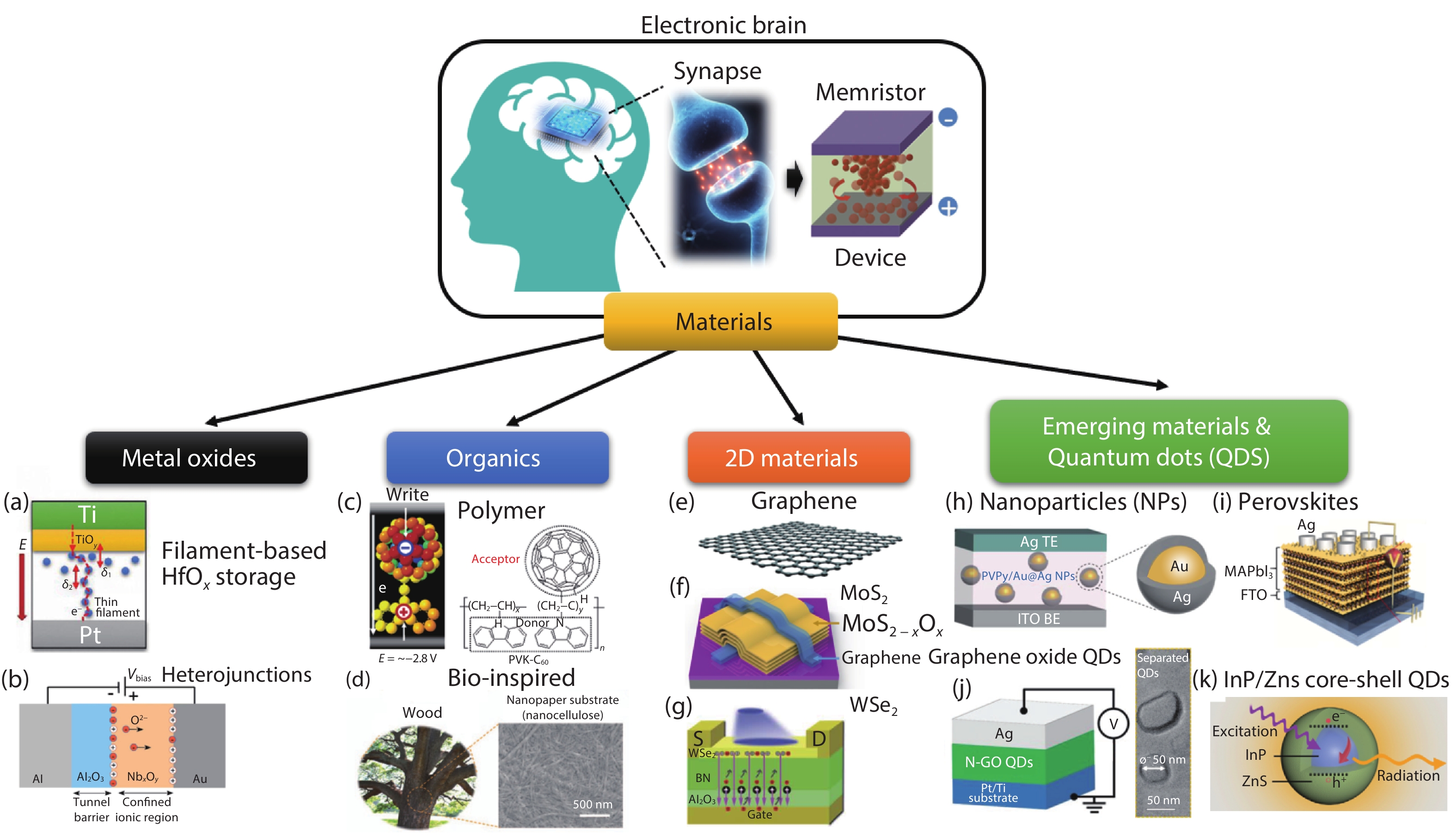
 DownLoad:
DownLoad:
